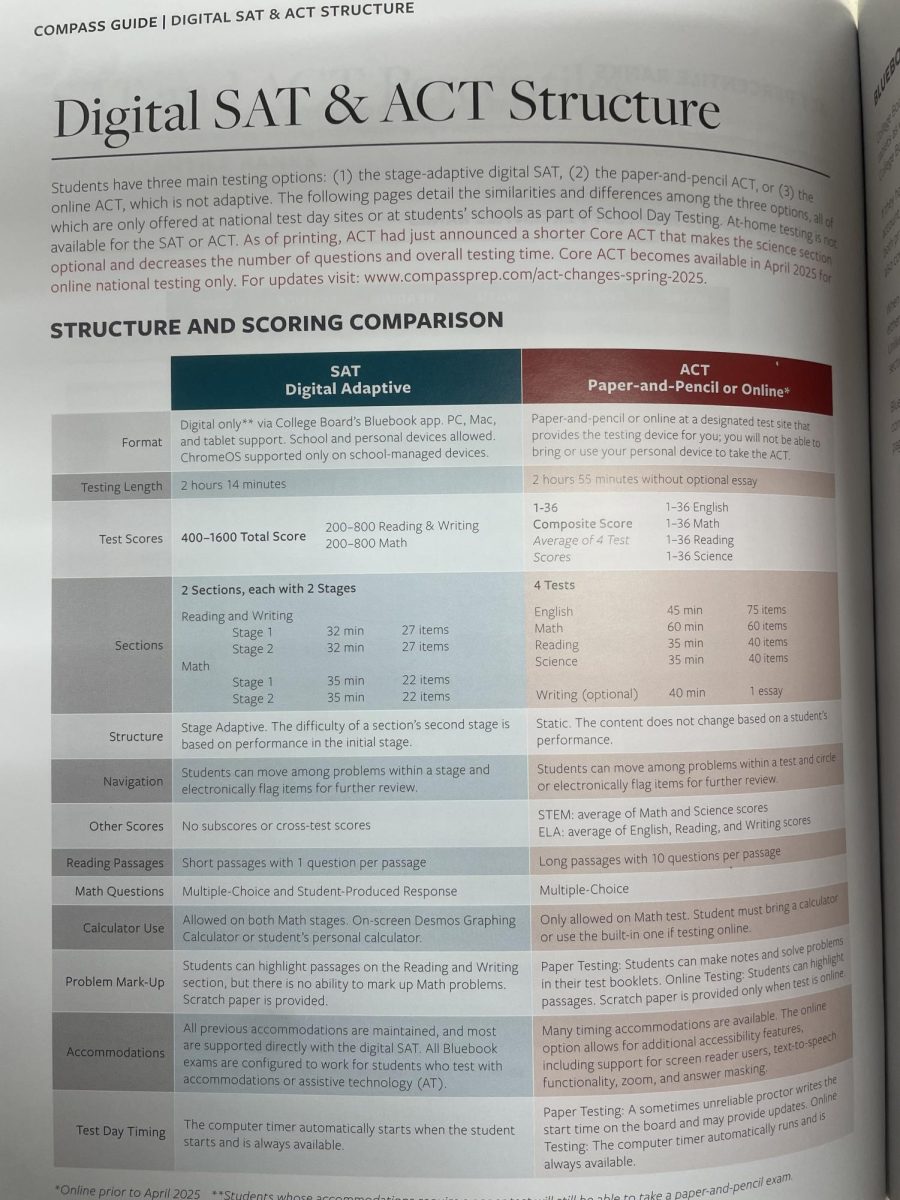As universities are shifting back to requiring test scores from applicants, it is important for students to perform well on their tests. Most American high school students take the Scholastic Assessment Test (SAT), but it might benefit them more to look at the American College Testing (ACT).
These exams measure students’ readiness for college-level courses and can have a significant impact on their chances of getting into better institutions. Additionally, high scores can give students large merit-based scholarships on top of whatever financial aid they receive for specific schools. As a result, students should use every advantage they can get when taking exams. They should take the ACT because of the paper format and question assortment.
As the SAT went fully digital in the spring of 2024, the ACT’s paper option gives students the advantage of freehand scratchwork and annotations.
“It was easier to circle or highlight things on the reading and English section,” senior James McCormac said. “Even in the math section, being able to circle the specific numbers you need is really helpful, whereas on the SAT you cannot highlight anything on the math questions.”
The SAT will likely update the annotation abilities in the math section, but the digital notes are still rough for now. Physically annotating questions and drawing out diagrams side-by-side with them is much easier and quicker than doing scratchwork on a computer screen.
Also, some students just feel more comfortable solving problems on paper simply because of their familiarity with paper tests.
“I think I did better on the ACT because of all the lines of bubbles for answer marks,” McCormac said. “I knew exactly how far I was through the test visually, compared to the SAT where I was just looking at a number out of so many questions.”
This was an opinion shared by many seniors who took the digital SAT at school last spring.
“I’ve talked to a lot of guys that said they didn’t feel very good about their [digital SAT] test,” senior Leonard Siegal said. “They felt that they would be better if they were taking it on paper.”
Siegal took both the ACT and SAT but performed significantly better on the ACT with a class-high score of 35. He enjoyed the mental aspect of being able to write down notes during the exam.
“There’s studies proving that written work is retained better in the mind,” he said. “There’s definitely an argument to be made that writing is better than typing and just clicking answers on a screen.”
There is also the risk of computer issues when taking the SAT.
“I have a Chromebook, which means I could not use my device for the SAT,” McCormac said. “Instead, I had to use one of the school computers. It would have been much easier to test on my own personal laptop.”
Even kids who tested on their own devices could have problems.
“Some kids have some beat-up iPads where it becomes very difficult to do an online test,” he said. “The screens can be cracked and some of the corners are blacked out, so the ACT is better because it gives more of an equal advantage to all students.”
This is not to mention the time when a significant number of classrooms in the school had issues with connecting to Bluebook (the SAT server), which postponed the test. So, while some kids perform well on digital tests, it is important to have the option of a paper test for the many students who prefer this alternative.
The ACT also provides students with a more efficient reading and English format. Where the ACT reading section has four long passages with ten questions each, and its English section has five long passages with fifteen passages each, the SAT reading and English section has fifty-four total questions with several short excerpts for every few questions.
Some students did not like this SAT style for the reading section.
“The reason I felt I did worse on the SAT is because they switched to shorter form passages for each question,” Siegal said. “I heavily dislike [this], because I think it is very time inefficient.”
McCormac, who also scored much higher on the ACT reading and English than SAT, agrees with this.
“I think it’s more valuable when testing if you can completely analyze one passage in depth compared to being able to superficially analyze a bunch of passages,” he said. “Having one passage that I can continuously look over and fully do is much better for me.”
However, some students do like the shortened passages.
“I felt like I was doing the test faster,” senior Ryan Clark said. “It made it a lot more streamlined for me.”
His ease with these questions came as a surprise to him.
“Reading is my least favorite part of all standardized tests, but I really liked the [SAT] reading,” he said. “I’m not a fan of those long paragraphs and the several questions per passage.”
While this may be the case, there is no denying that the junior and senior English classes prepare students more for the ACT. These classes have focused on long speeches, poems, and excerpts that often have tests with several questions per passage, just like the ACT.
Now, one of the simplest advantages that the ACT gives is a completely multiple choice-based test, whereas the SAT math section has some free-response questions.
The free-response questions are something that even the successful SAT test-takers disliked.
“That is definitely my least favorite part of the test,” Clark said. “You’re kind of throwing out a random answer real quick [if you’re having trouble] because you don’t have that multiple choice to lean on.”
The multiple choice test gives students a chance to eliminate some answers and give a good estimate.
This is not to mention that the ACT math questions progress from easiest to hardest, something students like.
“You’re not stuck puzzling over one question before you get to an [easy] question,” Siegal said. “It is generally linear with its difficulty progression.”
While the ACT can be an easier test based on its format of questions, the most important thing for students to do is try both tests.
“If I was to tell a student which test to take, it has to be up to them after they’ve taken both,” McCormac said. “You can’t make a choice about a test if you haven’t taken either yet.”








